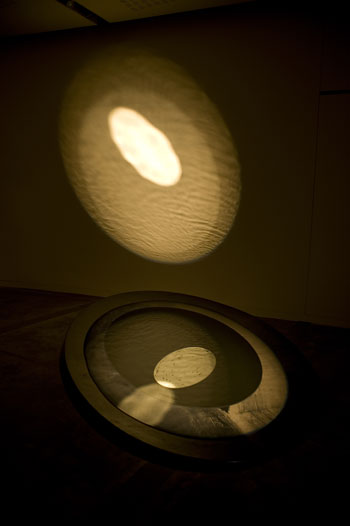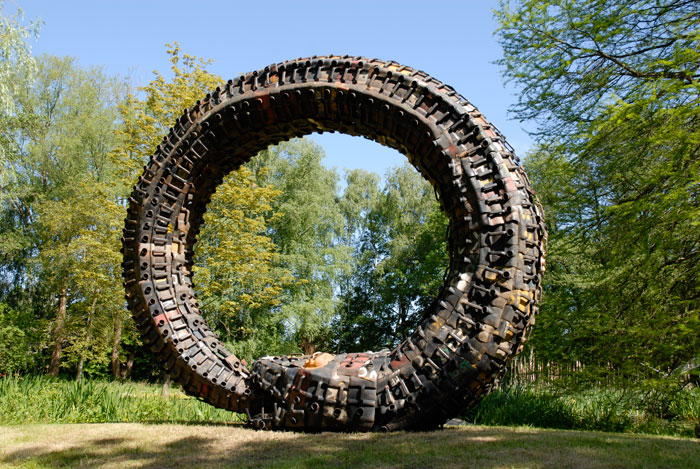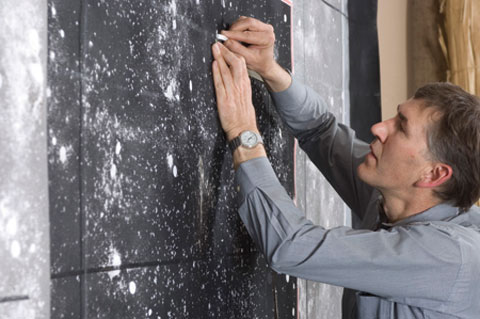
Willem Boshoff
b. 1951, South Africa
Slices of Air
2010
Belfast black granite
Collection of the artist
Moonstruck. While listening to an early morning radio program that broadcasts messages from long-distance truck drivers to family and friends, artist Willem Boshoff was struck by a caller's message to a loved one about the crescent moon--the same moon Boshoff could see through his car window. Like soundwaves emanating from their source, these crescents curve like the earth's surface and rise like the moon into the night sky. They are inscribed with the scientific names of the different levels of the earth's atmosphere.
|

Karel Nel
b. 1955, South Africa
Trembling Field
2009
Carbon silicate, etched dark mirror, water, light
Collection of the artist
Light reflections. In Karel Nel's meditative, interactive sculptural work Trembling Field, the gentle touch of the water's surface sets into motion a series of vibrations and delicate, random patterns of reflected light. This suggests the ephemeral and deeply evocative qualities of light as it diminishes into the far reaches of space.
In 2004 Nel was invited to participate as an artist in residence in COSMOS, the Cosmic Evolution Survey. This ongoing project involving more than a hundred scientists around the world is charged with mapping a two-degree square area of the sky. As the project explores the depths of the two-degree field, effectively moving back in time, light decreases.
|

Julie Mehretu
b. 1970, Ethiopia
Transcending: The New International
2003
Ink, acrylic on canvas
The Walker Art Center, Minneapolis, T. B. Walker Acquisition Fund, 2003, 2003.42
Expanding, disintegrating worlds. In Julie Mehretu's Transcending: The New International, amorphous cloud-like formations converge and diverge at a center glowing with light, as if to suggest a world in the process of collapsing and expanding. The layered composition is also constructed with urban plans from Africa's capital cities and with materials relating to the intersecting trajectories of history, migration, and struggle. In her works Mehretu explores the creation, evolution, collision, and destruction of worlds and the dynamic transformations of urban environments that are wrought by history, globalism, and assertions of power.
|

Romuald Hazoumè
b. 1962, Republic of Benin
Rainbow Serpent (Dan-Ayido-Houedo)
2007
Mixed media and found objects
Courtesy the artist and October Gallery, London
A vicious cycle. Romuald Hazoumè fashions a monumental, predatory creature--the rainbow serpent--out of recycled jerry cans that are typically used to carry gasoline. He addresses the exploitation of resources and how this affects communities around the world and over time, including the horrors of the transatlantic slave trade centuries ago and its economic equivalents today.
The circular image of the rainbow serpent swallowing its tail is a powerful symbol among Fon and Yoruba peoples in Benin and Nigeria, where it refers to spiritual forces and positive ideas about fertility, prosperity, and the eternal cycle of life.
|

William Kentridge
b. 1955, South Africa
Day for Night (still image from video)
2003
16mm film transferred to video (black and white, silent), 6:32 min.
William Kentridge (direction, drawing, and photography)
Catherine Meyburgh (editing)
Inner journeys to outer limits. Day for Night by South African artist William Kentridge provides a fascinating take on a familiar theme: the artist in his studio. The film maps the creative process, with its pressures and limitations, and brings live-action cinema into Kentridge's typical stop-motion animation work.
In Day for Night, part of the 7 Fragments for Georges Méliès, Kentridge creates the cosmos by having ants crawl across lines of sugar. When reversed from positive to negative, these "drawings" turn into visions of a shimmering and ever-changing galaxy. The title refers to the 1973 François Truffaut film La nuit américaine. (The title of the English-language version was Day for Night.)
|
|
Exhibit: |





